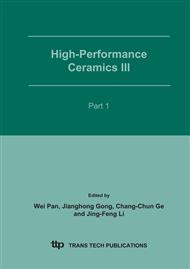p.281
p.285
p.289
p.293
p.297
p.301
p.305
p.311
p.315
The Role of Niobium in (Ca, Si, Ce, Nb)-Doped TiO2 Varistors
Abstract:
The present work attempted to investigate the effect of Nb addition on the electrical properties of the (Ca,Si,Ce,Nb)-doped TiO2 ceramics. The content of added niobium is in the range 0.1-1.0mol %, while that of the other additives keeps constant. The results showed that an optimal composition doped with 0.8mol% Nb2O5, followed by sintering at 1350°C, was obtained with low V1 mA of 7.22V, high nonlinear coefficient of 5.76, ultrahigh dielectric constant (er = 86000) as well as relatively low loss (tgd = 0.52) in room temperature at 1 kHz. SEM studies show that change of niobium had significant influence on grain growth and micro structural characteristics of the sintered samples.
Info:
Periodical:
Pages:
297-300
Citation:
Online since:
February 2007
Authors:
Price:
Сopyright:
© 2005 Trans Tech Publications Ltd. All Rights Reserved
Share:
Citation:


